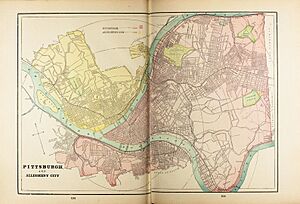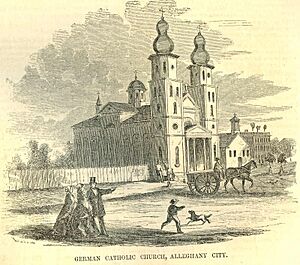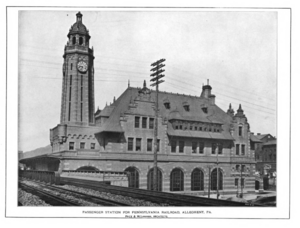Allegheny, Pennsylvania facts for kids
Quick facts for kids
Allegheny City
|
|
|---|---|

The Allegheny Post Office, one of the remaining structures of Allegheny City's downtown
|
|
| Country | United States |
| State | Pennsylvania |
| County | Allegheny |
| Founded | 1788 |
| Incorporated (borough) | 1828 |
| Incorporated (city) | 1840 |
| Annexed (Pittsburgh) | 1907 |
| Elevation | 1,370 ft (420 m) |
| Population
(1900)
|
129,896 |
| Time zone | UTC-5 (EST) |
| • Summer (DST) | UTC-4 (EDT) |
| ZIP Code |
15212, 15214, 15233
|
| Area code(s) | 412 |
Allegheny City was a town in Pennsylvania, United States, that existed from 1788 until 1907. It was located just north of Pittsburgh, across the Allegheny River. Today, this area is known as the North Side of Pittsburgh. The part of the city along the Allegheny and Ohio Rivers is now called the North Shore.
Allegheny City included many areas that are now Pittsburgh neighborhoods. These include Allegheny Center, Allegheny West, Brighton Heights, Central Northside, East Allegheny, Manchester, and Troy Hill.
History of Allegheny City
| Historical population | |||
|---|---|---|---|
| Census | Pop. | %± | |
| 1830 | 2,801 | — | |
| 1840 | 10,089 | 260.2% | |
| 1850 | 21,262 | 110.7% | |
| 1860 | 28,702 | 35.0% | |
| 1870 | 53,180 | 85.3% | |
| 1880 | 78,682 | 48.0% | |
| 1890 | 105,287 | 33.8% | |
| 1900 | 129,896 | 23.4% | |
Allegheny was planned in 1788 by John Redick. Land was sold or given to Revolutionary War veterans. It became a borough in 1828 and a city in 1840.
Before the 1850s, much of the area was farmland. Later, it was divided into smaller lots for homes. Many German immigrants moved there first, followed by Croat immigrants. People often called it "Deutschtown," which means "German town."
Allegheny grew by adding nearby towns like Manchester and Spring Garden. It also added areas that became Brighton Heights and Troy Hill.
How Allegheny City Joined Pittsburgh
Allegheny City became part of Pittsburgh in 1907. This happened after a special vote in 1906. Most people in Allegheny City did not want to join Pittsburgh. However, a new state law allowed cities to merge if more people in the combined areas voted yes. Pittsburgh had many more people, so the merger passed.
Allegheny City residents tried to stop the merger in court for years, but they were not successful. After the merger, Pittsburgh's population grew a lot. In 1900, Pittsburgh had about 321,000 people. By 1910, it had over 533,000 people, including the 132,000 from Allegheny.
When the two cities joined, their old ward systems were changed. Allegheny was divided into new wards, from 21 to 27. You can still see its old territory on a map of Pittsburgh's wards.
Changes to Allegheny City's Downtown
In the 1960s, Pittsburgh started a big project to rebuild the center of Allegheny City. Many old buildings were torn down. Only the Commons of Allegheny Center and some surrounding neighborhoods remained.
Some important buildings were saved. These include the Carnegie Library, the Old Post Office Building, and the Buhl Planetarium. Many neighborhoods like Allegheny West and Mexican War Streets are now listed as historic places.
What Allegheny City Made
Allegheny was a busy industrial city. It had many businesses, churches, and groups. Factories made things like packed meats, leather, soap, and glue. These jobs were important for the many German immigrants who lived there.
The H.J. Heinz Company built its famous factory in Allegheny City. It was near the Chestnut Street bridge. Another company, Heyl & Patterson Inc., made large machines for loading and unloading ships. Today, some of these old factory buildings are used as warehouses or bus garages.
By the mid-1800s, many different products were made in Allegheny. These included iron, rope, plows, cloth, food, paper, and steam engines. Railroad lines were also built along the Allegheny River. These lines helped transport goods and people.
Historic Places to Visit
Teutonia Männerchor
The Teutonia Männerchor Hall was built in 1888. It is in the East Allegheny neighborhood. This club helps keep German traditions alive. Members sing German songs and do folk dances. It was added to the National Register of Historic Places in 2004.
The Priory
The Priory includes two historic buildings. One is the St. Mary's German Catholic Church, built in 1852. The other is a home for Bavarian Benedictine priests, built in 1888. The church and rectory are now closed. The buildings are used as a banquet hall and a bed-and-breakfast.
Penn Brewery
Penn Brewery started in 1987. It is located in the old Eberhardt & Ober Brewery buildings, which date back to 1882. Penn Brewery makes popular beers like Penn Pilsner. Their restaurant serves German food and has live music.
Saint Nicholas Church
Saint Nicholas Croatian Catholic Church was the first Croatian Church in the United States. It was located on a hillside above the Allegheny River. The building was taken down in 2013.
Ridge Avenue Neighborhood
Between 1890 and 1910, Ridge Avenue was known as "Millionaires' Row." Many wealthy families lived there. After Allegheny joined Pittsburgh in 1907, the area started to change.
Mexican War Streets
In the late 1800s, Allegheny was known for its grand homes. One area became known as The Mexican War Streets. These streets were named in 1847 by William Robinson Jr.. He named them after battles and generals from the Mexican–American War. Examples include Buena Vista Street and Monterey Street.
Carnegie Free Public Libraries
Andrew Carnegie helped fund and build the Carnegie Free Library of Allegheny in Allegheny City. He was a famous businessman and giver.
St. Anthony Chapel
St. Anthony Chapel was built on Troy Hill between 1880 and 1892. It has a very large collection of religious items. It also features life-sized statues showing the Stations of the Cross.
Ballparks
Allegheny City was home to Exposition Park and Recreation Park. These were the first home fields for the Pittsburgh Pirates baseball team. Today, PNC Park (home of the Pirates) and Acrisure Stadium (home of the Pittsburgh Steelers football team) are on the North Side of Pittsburgh.
Felix Brunot Mansion
The Felix Brunot mansion was once a stop on the Underground Railroad. This was a secret network that helped enslaved people escape to freedom. People fleeing slavery found food and shelter here. Many continued their journey to Canada to be even safer.
Allegheny Observatory
The first Allegheny Observatory was built in 1859. It was used to study stars, the sun, and planets. It also provided accurate time to railroads using telegraphs. A new Allegheny Observatory was built between 1900 and 1912. Today, the University of Pittsburgh uses it for research and public tours.
Famous People from Allegheny City
Many notable people were born or lived in Allegheny City:
- Nellie Bly (1864-1922) - A famous American journalist and inventor.
- John A. Brashear (1840–1920) - An engineer who made scientific instruments.
- Andrew Carnegie (1835–1919) - A Scottish immigrant who became a very rich steel businessman and gave away much of his money.
- Mary Cassatt (1844–1926) - An American impressionist painter.
- Willa Cather (1873–1947) - An American novelist who taught English at Allegheny High School.
- David L. Clark (1864–1939) - The founder of the D. L. Clark Company, which made the Clark Bar candy.
- Martha Graham (1894–1991) - A famous modern dancer and choreographer.
- Robinson Jeffers (1887–1963) - A poet known for his long poems.
- Samuel Pierpoint Langley (1834–1906) - A pioneer in aviation and an astrophysicist.
- Dwight Morrow (1873–1931) - A banker and diplomat.
- Henry Phipps, Jr. (1839–1930) - A financier and giver.
- John Pitcairn (1841–1916) - An industrialist who founded PPG Industries.
- Mary Roberts Rinehart (1876–1958) - A mystery author.
- William Robinson, Jr. (1785–1868) - The first mayor of Allegheny City.
- Art Rooney (1901–1988) - The founder of the Pittsburgh Steelers football team.
- Charles Taze Russell (1852–1916) - The first president of the Watch Tower Bible and Tract Society.
- Leo Stein (1872–1947) - An art collector and critic.
- Gertrude Stein (1874–1946) - An American avant-garde writer.
- Lois Weber (1879–1939) - A pioneer silent film actor, writer, producer, and director.






